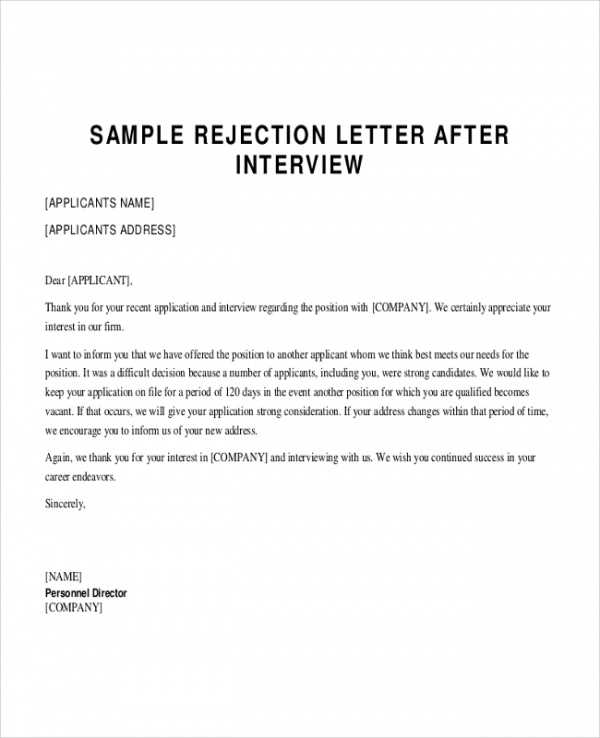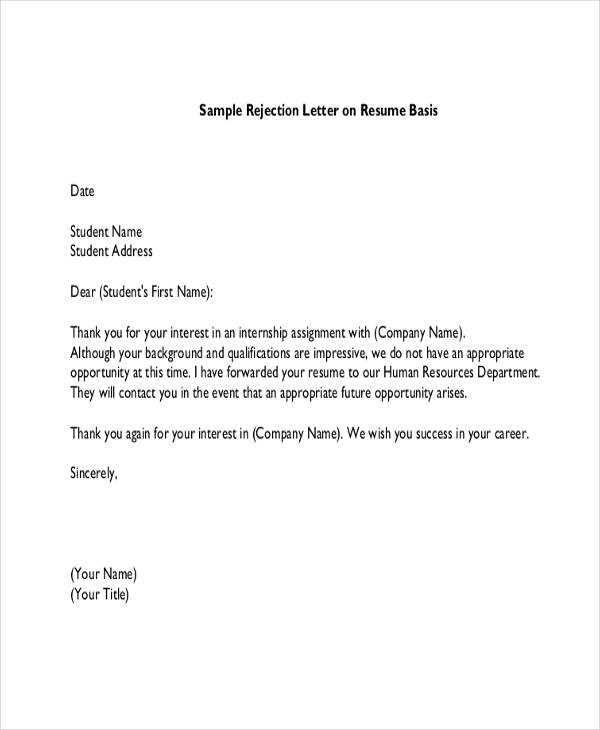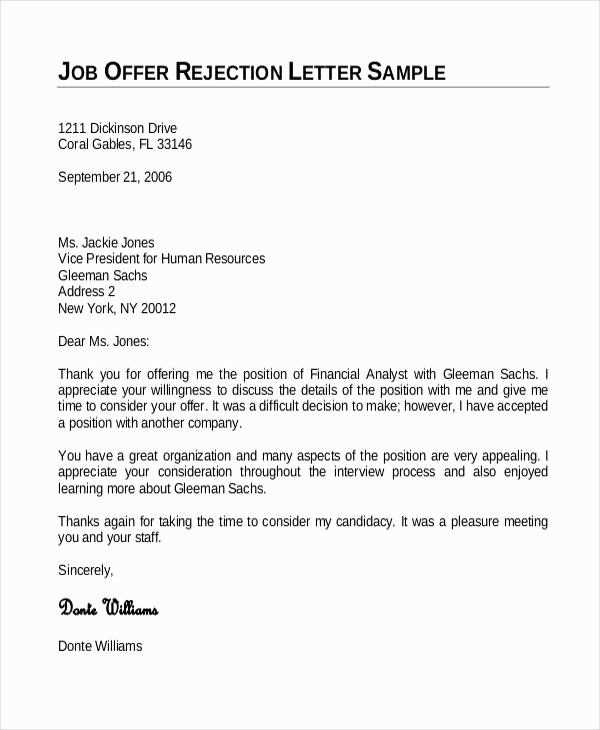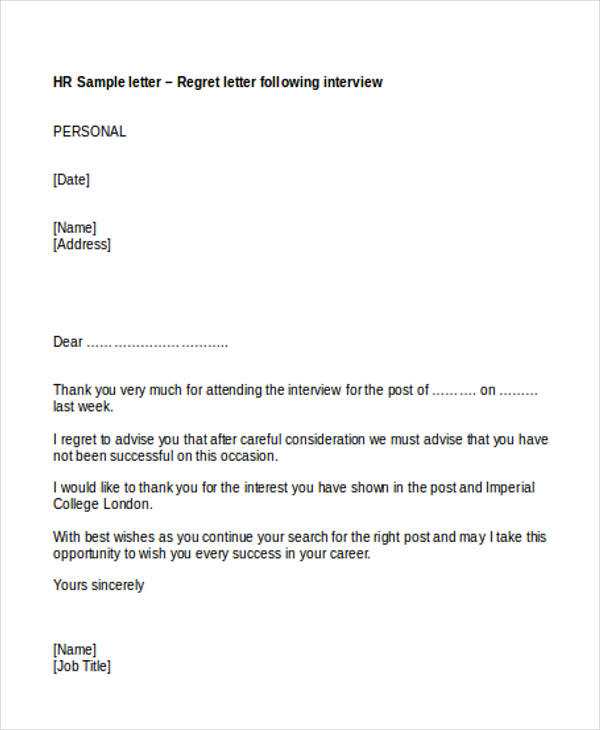HR Rejection Letter Template for Professional Use

Handling candidate responses is an essential part of the recruitment process. It’s crucial to deliver news about hiring decisions in a way that respects the individual’s efforts while maintaining professionalism.
Crafting a thoughtful and clear message can make all the difference in preserving a positive relationship with applicants. A well-written response ensures the candidate feels valued despite the outcome, leaving the door open for potential future opportunities.
Understanding the right approach and structure is key to creating an impactful communication that reflects your organization’s values and fosters respect towards all individuals involved in the hiring process.
Why HR Rejection Letters Matter
Communicating hiring decisions thoughtfully is an integral part of maintaining a positive organizational reputation. The way you notify candidates about the outcome of their applications plays a significant role in how your company is perceived by both successful and unsuccessful applicants.
Sending a considerate response ensures that candidates walk away with a sense of respect and professionalism. It can also encourage candidates to stay engaged with your company for future opportunities, even if they were not selected this time.
Building a Positive Employer Brand
A well-crafted response helps shape your company’s image. When candidates feel valued during the selection process, regardless of the outcome, they are more likely to share positive feedback and recommend your organization to others, improving your employer brand.
Maintaining Professional Relationships

Notifying applicants in a respectful manner can strengthen professional connections. This can lead to potential collaborations, networking opportunities, or even future hiring possibilities as candidates remain open to reapplying for different roles.
Essential Components of a Rejection Letter
When informing candidates about hiring decisions, clarity and tact are essential. A well-structured message not only communicates the decision but also leaves a positive impression, fostering respect and professionalism.
The key to crafting an effective response lies in including specific elements that convey the message clearly while maintaining a respectful tone. These components help ensure the candidate understands the outcome and feels valued despite not being selected.
- Personalized Greeting: Address the candidate by name to create a more personal connection and avoid sounding robotic.
- Appreciation for Application: Acknowledge the candidate’s interest and effort in applying for the position.
- Clear Decision: Clearly state the outcome of their application, making it easy to understand.
- Encouragement for Future Opportunities: Encourage candidates to stay in touch or apply for future roles within the company.
- Professional Closing: End the message on a positive note with a polite and professional sign-off.
Including these elements helps maintain a professional and respectful tone, ensuring that candidates are informed and appreciated, even when the outcome is not what they hoped for.
How to Maintain Professionalism in Rejections
Delivering unfavorable news to candidates can be challenging, but it is crucial to approach it with respect and professionalism. By maintaining a considerate and tactful tone, you ensure that candidates are treated fairly and that your company’s reputation remains strong.
To uphold professionalism, focus on clarity, empathy, and transparency. Keeping communication direct yet respectful helps avoid misunderstandings and shows that your organization values the time and effort candidates invested in the process.
Be Clear and Concise
When informing a candidate of the outcome, be straightforward while avoiding unnecessary details. Clearly state the decision, making it easy to understand, while ensuring the tone remains respectful and kind.
Express Gratitude and Respect
Acknowledge the candidate’s qualifications and efforts. Showing appreciation, even in the face of an unfavorable outcome, helps maintain a positive relationship and demonstrates that their application was valued.
Best Practices for Writing Clear Responses

Effective communication is essential when conveying a decision to candidates. Clear, direct, and respectful messaging ensures that applicants fully understand the outcome and leave with a positive impression of your company.
By following a few key guidelines, you can ensure that your responses are concise, professional, and considerate. These best practices help avoid confusion and ensure a smooth communication process.
Focus on Simplicity and Clarity
Avoid using overly complex language or jargon. The message should be simple, making it easy for the candidate to understand the decision quickly.
Maintain a Positive and Respectful Tone

Even when delivering difficult news, maintaining a respectful and positive tone shows empathy for the candidate’s situation, leaving the door open for future opportunities.
| Practice | Explanation |
|---|---|
| Be Direct | Clearly state the decision without ambiguity, ensuring the candidate knows the outcome. |
| Be Empathetic | Show appreciation for the applicant’s time and effort, acknowledging their qualifications. |
| Use a Professional Tone | Maintain a respectful, courteous tone throughout the message to uphold your company’s image. |
| Offer Future Opportunities | Encourage candidates to apply again or stay in touch for future roles within the company. |
Tailoring Rejection Letters for Specific Roles

Adapting your message based on the role a candidate applied for can make the communication feel more personalized and thoughtful. When rejecting applicants for different positions, it’s important to adjust your response to reflect the unique nature of the role and the specific skills or experiences that were required.
By tailoring the message, you not only acknowledge the candidate’s qualifications but also show that you have carefully reviewed their application. This approach helps maintain a positive relationship and encourages candidates to consider future opportunities within your organization.
For instance, if the applicant was being considered for a highly technical position, you could reference specific skills or experiences they may have demonstrated during the process. Similarly, for creative roles, a mention of their portfolio or innovative ideas can add a more personalized touch.
Common Mistakes to Avoid in Rejections
When delivering unfavorable news to candidates, there are several pitfalls to avoid. Mistakes in the communication process can damage relationships, harm your company’s reputation, and leave candidates with a negative impression.
Avoiding these errors ensures that the message is delivered professionally and respectfully, maintaining a positive rapport with all applicants. It’s important to be mindful of how your words may be interpreted and the lasting impact they can have.
For example, using vague or overly generic language can confuse the recipient or make them feel undervalued. Similarly, failing to provide a clear explanation or closure can leave candidates wondering about the specific reasons behind the decision.